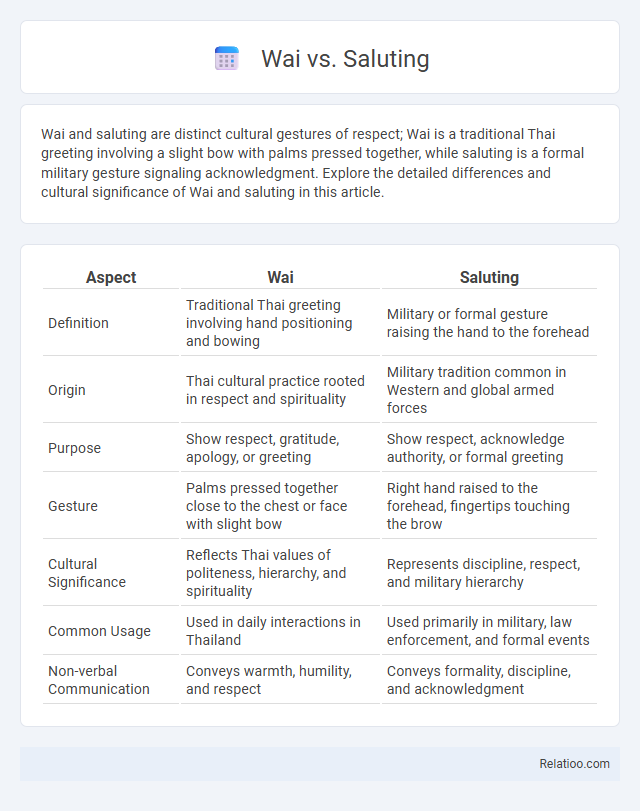Wai and saluting are distinct cultural gestures of respect; Wai is a traditional Thai greeting involving a slight bow with palms pressed together, while saluting is a formal military gesture signaling acknowledgment. Explore the detailed differences and cultural significance of Wai and saluting in this article.
Table of Comparison
| Aspect | Wai | Saluting |
|---|---|---|
| Definition | Traditional Thai greeting involving hand positioning and bowing | Military or formal gesture raising the hand to the forehead |
| Origin | Thai cultural practice rooted in respect and spirituality | Military tradition common in Western and global armed forces |
| Purpose | Show respect, gratitude, apology, or greeting | Show respect, acknowledge authority, or formal greeting |
| Gesture | Palms pressed together close to the chest or face with slight bow | Right hand raised to the forehead, fingertips touching the brow |
| Cultural Significance | Reflects Thai values of politeness, hierarchy, and spirituality | Represents discipline, respect, and military hierarchy |
| Common Usage | Used in daily interactions in Thailand | Used primarily in military, law enforcement, and formal events |
| Non-verbal Communication | Conveys warmth, humility, and respect | Conveys formality, discipline, and acknowledgment |
Introduction: Understanding Wai and Saluting
Wai and saluting are traditional gestures of respect rooted in cultural and military practices respectively, each carrying distinct symbolic meanings. The Wai, originating in Thai culture, involves a slight bow with palms pressed together and signifies respect, gratitude, or greeting, often used in social and religious contexts. Your understanding of these rituals enhances cross-cultural communication by recognizing the appropriate use of Wai or saluting based on social or official settings.
Historical Origins of Wai and Saluting
The Wai originates from ancient Thai culture as a gesture of respect and humility, rooted in Brahmanical and Buddhist traditions dating back over a thousand years. Saluting, historically linked to military customs from Roman times through medieval Europe, symbolizes discipline and recognition of authority within hierarchical structures. Your understanding of these rituals highlights the distinct cultural values and historical contexts that shaped the Wai's spiritual reverence versus the salute's formal acknowledgment.
Cultural Significance of Wai
The Wai holds profound cultural significance in Thai society, symbolizing respect, humility, and social hierarchy through precise hand gestures and bowing techniques. Unlike general greetings or saluting rituals, the Wai reflects deep-rooted traditions and spiritual values, reinforcing interpersonal harmony and spiritual connection. Your understanding of the Wai enriches cross-cultural communication by highlighting the nuanced expression of reverence unique to Thailand.
Cultural Significance of Saluting
Saluting holds profound cultural significance as a formal gesture of respect and acknowledgment across military and civilian contexts worldwide. Unlike the more casual Wai and Greeting rituals rooted in social or personal interactions, saluting symbolizes discipline, hierarchy, and mutual respect within structured organizations. This ritual unites members through a shared tradition that reinforces identity, honor, and protocol.
Key Differences Between Wai and Saluting
The Wai is a traditional Thai gesture involving a slight bow with palms pressed together, symbolizing respect and reverence, while saluting is a formal military gesture involving raising the right hand to the forehead as a sign of acknowledgment and discipline. Wai expresses social hierarchy and cultural etiquette in everyday interactions, contrasting with the saluting ritual's strict association with armed forces and official protocols. Greetings vary globally but the Wai remains unique for its spiritual and cultural significance in Thailand, unlike the more functional and standardized practice of saluting.
Appropriate Contexts for Wai
The wai is appropriate in formal Thai settings requiring respect, such as greeting elders, monks, or superiors, and during religious ceremonies. Your use of the wai conveys politeness and cultural understanding, especially when meeting someone for the first time or expressing gratitude. Unlike casual greetings or saluting, the wai emphasizes social hierarchy and is context-sensitive, making it essential to observe local customs.
Appropriate Contexts for Saluting
Saluting is a formal gesture predominantly used in military and official contexts to show respect and acknowledgment between ranks or towards superiors. Your understanding of when to salute ensures adherence to protocol, such as during flag ceremonies, official inspections, or when encountering officers in uniform. Unlike the Wai, common in Thai culture as a polite greeting, or general greeting rituals, saluting requires strict observance of hierarchical and situational appropriateness.
Wai and Saluting in Modern Society
The Wai and Saluting rituals serve distinct social functions in modern society, with the Wai primarily used in Thai culture as a respectful greeting involving hands pressed together and a slight bow, symbolizing gratitude and humility. Saluting, commonly seen in military and formal settings worldwide, functions as a gesture of respect and acknowledgment of authority or camaraderie. Both practices maintain cultural significance, fostering respect and social cohesion despite evolving societal norms.
Common Mistakes and Misinterpretations
Confusing the wai, saluting, and greeting rituals often leads to common mistakes such as using the inappropriate gesture for the cultural context, which can cause unintended disrespect. Many people misinterpret the wai as a simple bow, overlooking its significance in Thai culture as a sign of respect and social hierarchy. Your understanding of these distinct rituals improves by recognizing that the saluting gesture is military-specific, the greeting handshake is more Western, and the wai requires specific hand positioning and head nodding to convey proper reverence.
Conclusion: Choosing Respectful Greetings
Selecting the appropriate respectful greeting depends on cultural context and social norms, with the Wai in Thailand exemplifying a deeply rooted gesture symbolizing respect and humility. Saluting serves as a formal acknowledgment of rank and discipline in military and official environments, reinforcing hierarchy and protocol. Greeting rituals worldwide fundamentally express respect and connection, making awareness of their meanings essential for effective and considerate intercultural communication.

Infographic: Wai vs Saluting
 relatioo.com
relatioo.com